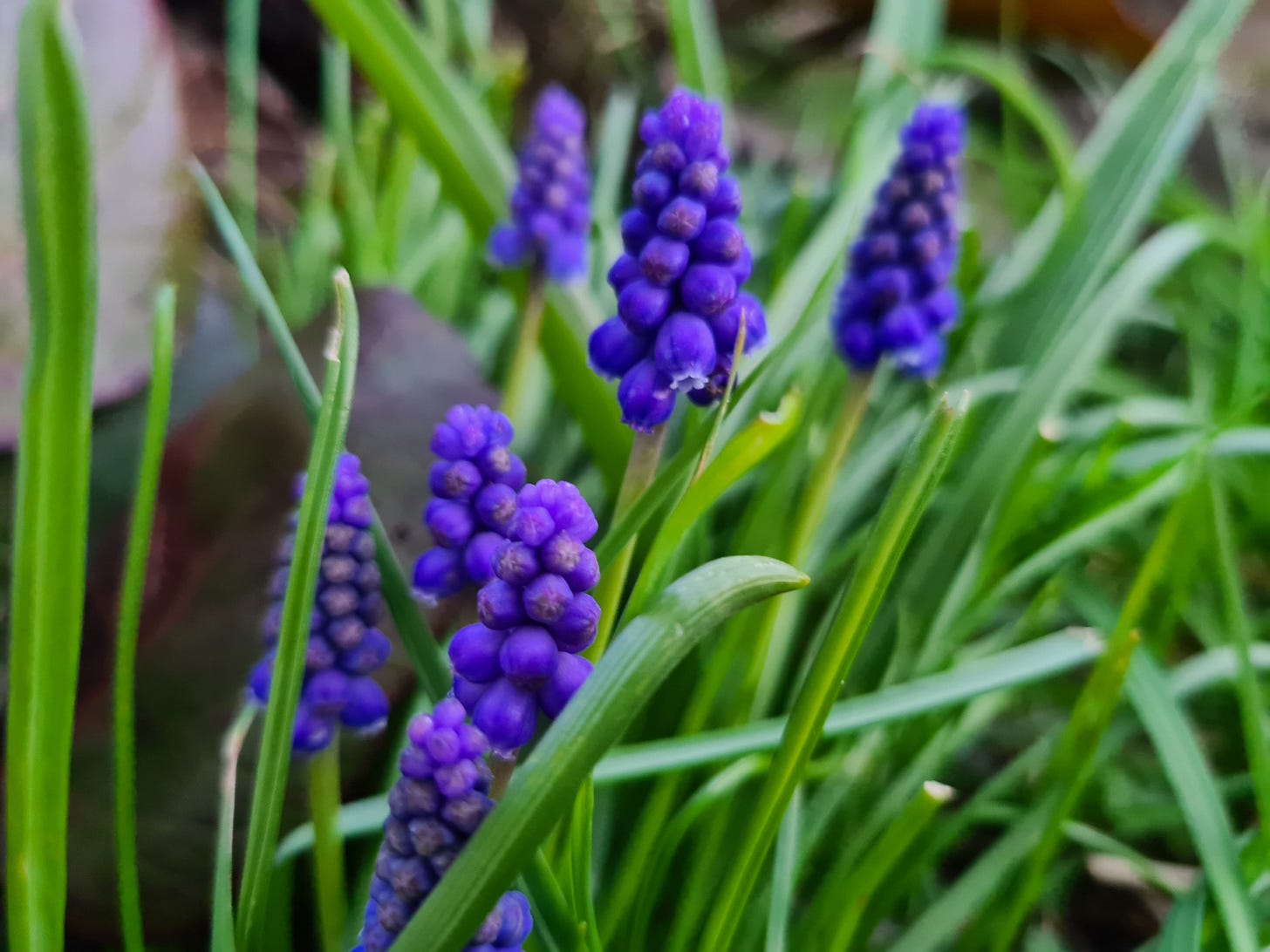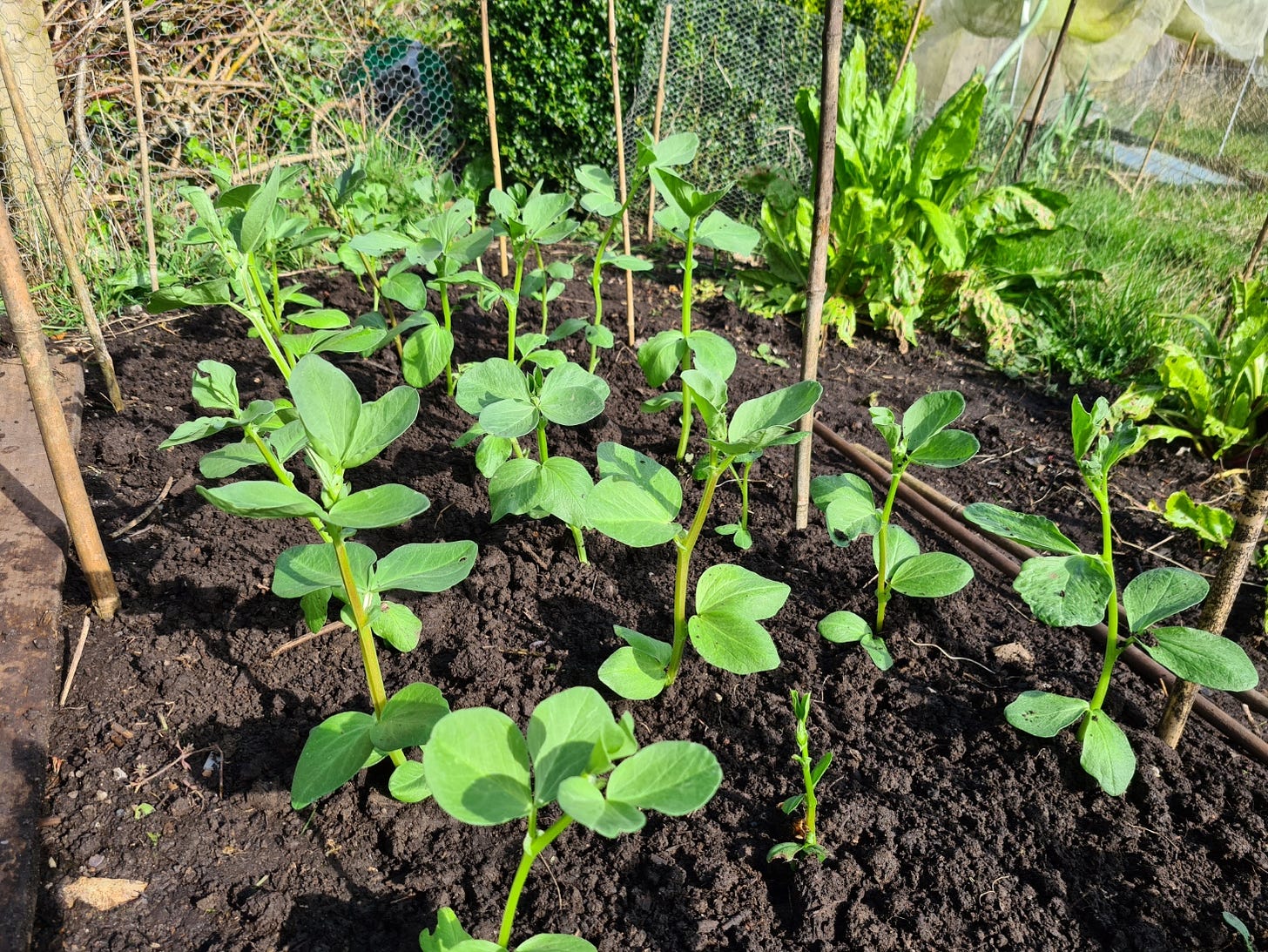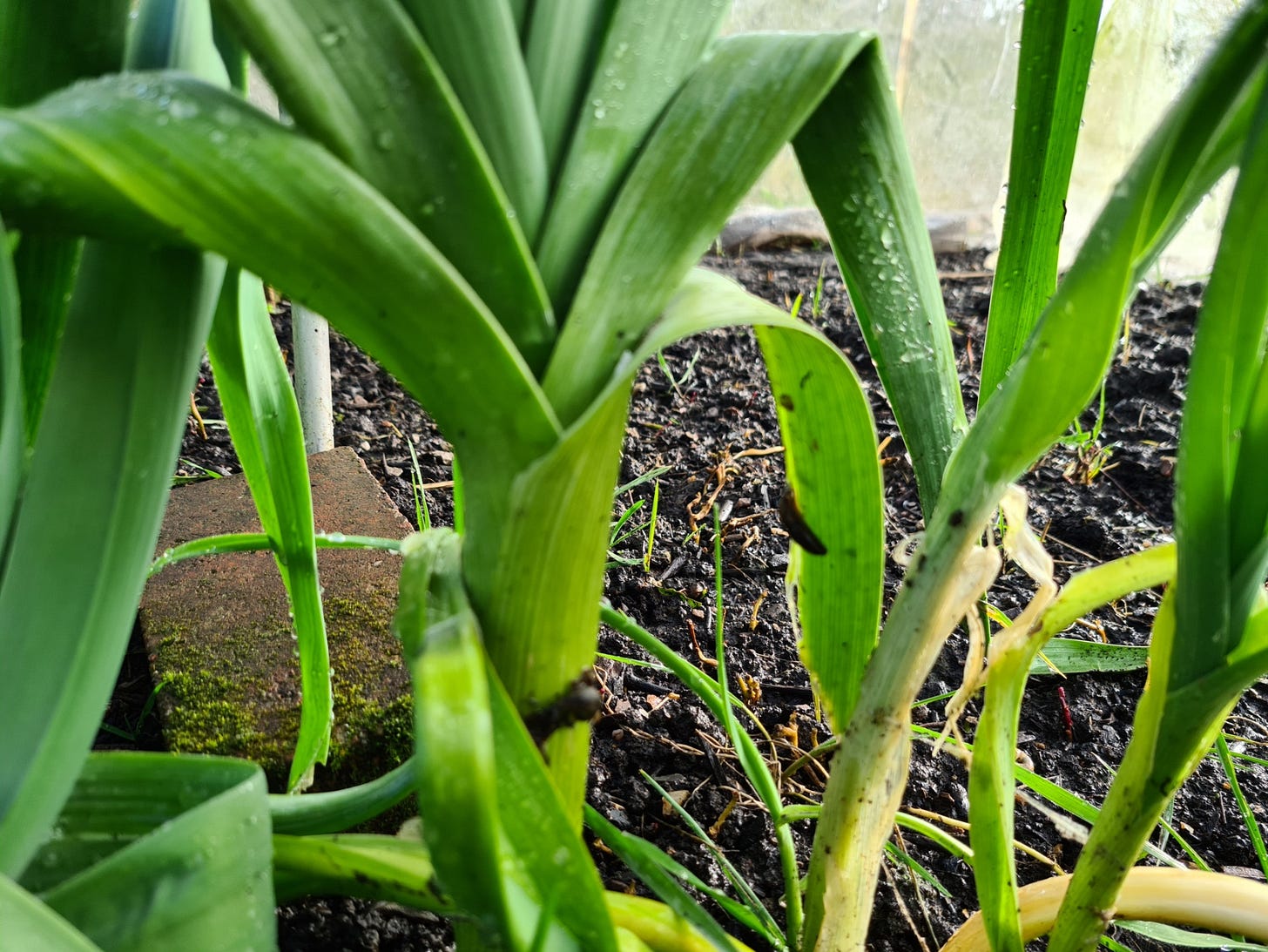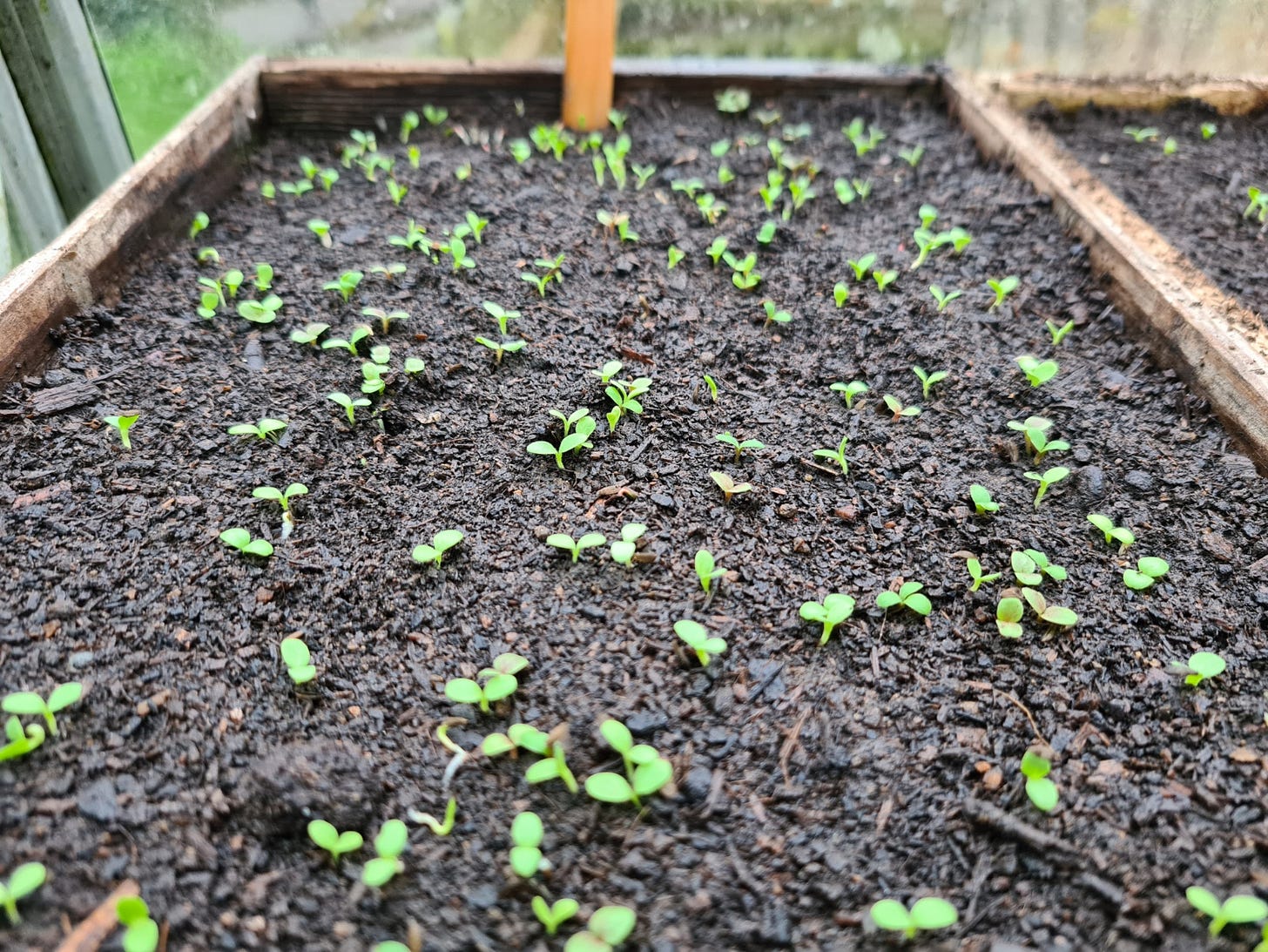There has been planting!
The ground has – just – dried out enough and is now on the slightly squidgy side of damp rather than actual soup, and my poor broad bean seedlings have already been waiting a month longer than they would normally to go out. So I seized the day and popped them outside, a little taller and a little leggier than is ideal but nonetheless settled in to the soil at last.
It’s amazing what you can get away with when it comes to timing and the garden. We are sticklers for timetables, we gardeners: books, blogs, vlogs and even seed packets will tell you with great authority what to do when (I have been guilty of this myself on occasion). But what they should actually be saying is that there is a window – quite often a wide window – within which you can sow, plant and reap: and it’s far more important to look at the sky, test the state of the soil, and take careful note of the weather forecast for the week ahead.
You can wait to plant out your seedlings if they’re better off indoors for now. You can sow salads well beyond the standard July timing they give on seed packets: I’m usually still sowing lettuces, annual herbs, spring onions and the rest well into September and October. I often sow one last batch in November, not expecting to pick them until spring: the little overwintering seedlings burst into life from February or March, giving you much earlier hungry gap salads to eat from around late March.
Even if you don’t get around to sowing at the ‘right’ time due to life getting in the way, or you just couldn’t be bothered, you still have a good month or so of leeway in which you can put that right. Sow your courgettes in April, they say: but in truth, if you sow in May they’ll still catch up on lost time and you’ll still be overrun with courgettes to pick by August.
That said, doing things earlier than you ‘should’ does carry a risk. Sow too early and you’ll have to nurse seedlings through a time when they really shouldn’t be growing, with heat mats and grow lights and all the rest of the paraphernalia. It gives you something to do in early spring, but it’s heavy on resources and energy, and not a green way to grow plants.
So treat ‘official’ dates as starting points – the earliest you can do something. Stretch them out by a month or so for slow-growing plants like tomatoes, squash, sweetcorn or cucumbers, and more for fast-growing veg like lettuce, turnips, beetroot, annual herbs, radishes and so on: you’ll find the sky stays in place and your harvest comes at roughly the same time anyway.
We are now well into the hungry gap, and I’m having to buy potatoes again having eaten my stores long ago. And carrots; I could, if I were organised enough, have a crop of little round-rooted ‘Paris Market’ carrots in a container somewhere by now, as they are very resilient and you can sow them very often and for most of the year – a bit like salad leaves. But no; perhaps next year I’ll do better.
But there is still much to pick. I am harvesting leeks still – I planted lots last year, so the supplies are lasting well into spring – and celeriac which has withstood the bad weather really well. Plus parsnips, and perennial kale, and spring onions. Now we’re in March, the rhubarb has joined the party: tall and handsome, my Timperley Early keeps me in fresh fruit when there’s none other to be found.
The overwintered salads (sown last November – see above) are now almost at picking size too, so in a week or so I should be enjoying the first fresh leaves: this year, ‘Black Seeded Simpson’ winter lettuces, mizuna, American land cress (lovely, peppery and a lot easier than watercress) and claytonia.
I’ve also been doing battle with the glass barn cloches I mentioned last weekend: goodness it’s been a test of my patience. I thought there might be a knack to it, and so it has proved: after many Youtube videos from all corners of the globe I have finally mastered the art of glass-and-wire origami to the point where I can now produce a sturdy cloche out of four pieces of glass and some old twisty metal in a matter of minutes. It’s rather satisfying, actually, especially that finally flourish when you snap the whole thing together with a deft twirl of the wrist. Well, sort of.
Anyway: I am going to see if I can find a way of producing a video for you so I can include all those little ‘a-ha!’ moments when I finally figured out that small but essential detail which the last video I watched had neglected to mention. Youtube does have its limitations.
As soon as they’re assembled, I’m lining them up on the soil where they’ll stay for a week or so distilling the sunshine, drying things out and generally warming up enough space to start sowing. I wouldn’t dare sow anything directly outside yet (even though it says I can on the seed packets) – even without the rampaging slugs (worse than usual this year thanks to the warmer winter) it’s far too wet and chilly still. But it is a little frustrating as I usually have at least a row or two of rocket and carrots in by now. So I am hoping the cloches will be a game changer, allowing me to put in a row or two safe from the relentless rain; I can’t guarantee they’ll be slug proof, though.
I hope things are starting to dry out a little in your gardens too: I am beginning to think we’ll just be crashing straight from winter into summer the way things are going. Give it a month or two and we’ll all be gasping in the heat, cursing ourselves for not saving more rainwater while we could. Ah well - that’s gardening for you!








I don’t think we’ve taken as much of a battering from the rain as you have down in the south west. We’ve had rain and a lot of people are complaining about it but we seem to be getting sunny spring days dotted in between. It’s not hampered the trips to the allotment (I tend to go for a couple of hours once a week) and in the garden I’ve often found an afternoon in a weekend to let the hens out. My current project in the garden is putting a heavy mulch of homemade compost on the flower beds (my flowerbeds have a mix of flowers and edibles - blueberries, Szechuan pepper, winter savoury, oregano, peonies, geranium (not pelargonium), Japanese anemones, herb fennel, wild strawberries, plantain, ox-eye daisies, calendula, babbington leeks, cardoons, globe artichokes, Camelia, holly hocks, apricot, olive and iris).the hens come and help spread the mulchy compost in their own scratchy way. I’ve not tried this before on the flower beds, they usually get baked in the summer being heavy clay so I’ll be interested to see what this does for the soil. I’ve been giving this treatment to the raised veg beds for years and I started by filling these with garden soil and top up with homemade compost/mulch in autumn and if vacant in spring a couple of months before planting and it had really improved the soil. We are hoping we’ve already had April showers and April will be a lovely month!
Hi Claire, I do love the sound of your hens 😊 how do you find Szechuan peppers? I've wanted a plant for ages - have you managed to actually dry the berries for pepper?